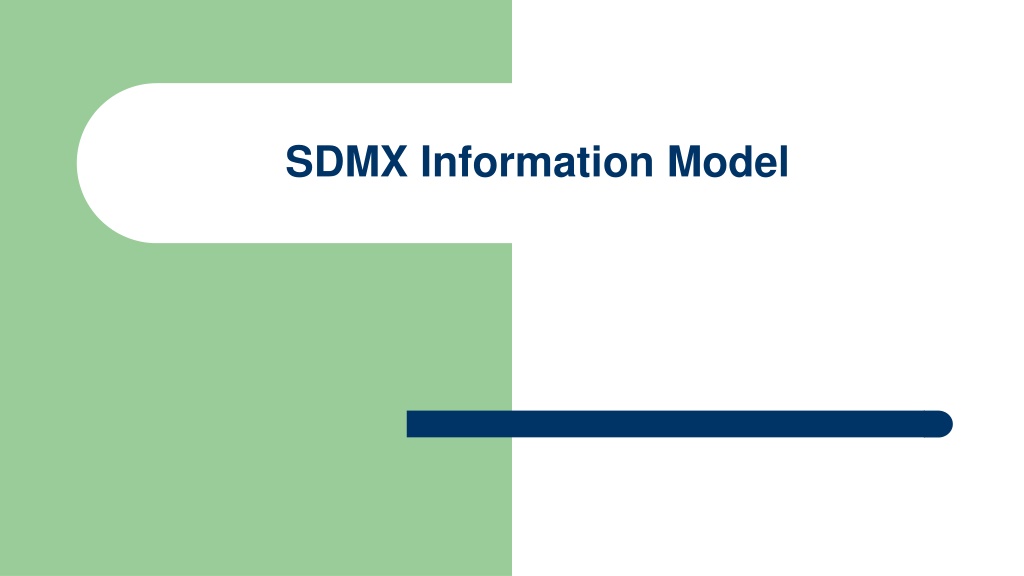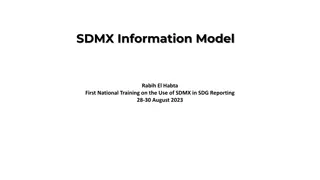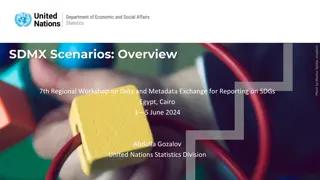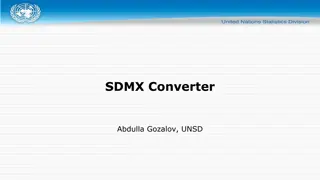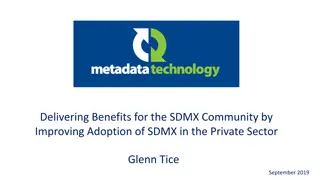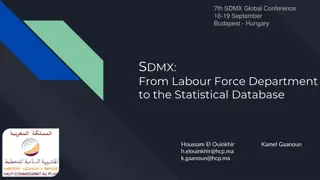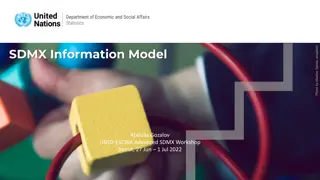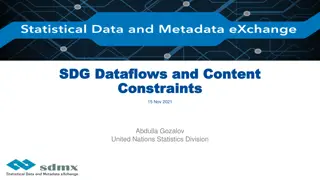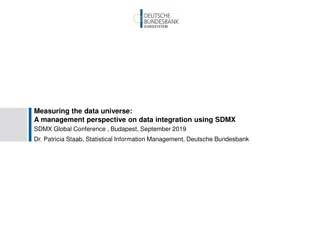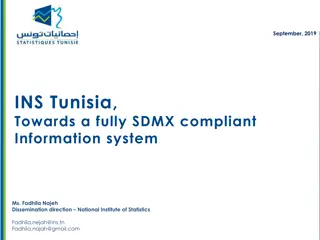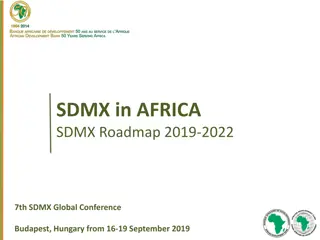Understanding Data Models in the Context of SDMX
Explore the importance of properly describing data, developing a data model for exchange, and identifying concepts in the SDMX context. Figures vs. data on the number of touristic establishments in Italy, along with visuals, illustrate key concepts like Data Structure Definitions. Learn how to identify concepts such as indicators, time periods, and units in data analysis.
Download Presentation

Please find below an Image/Link to download the presentation.
The content on the website is provided AS IS for your information and personal use only. It may not be sold, licensed, or shared on other websites without obtaining consent from the author. Download presentation by click this link. If you encounter any issues during the download, it is possible that the publisher has removed the file from their server.
E N D
Presentation Transcript
Figures vs data Number of touristic establishments in Italy, annual data Italy Annual data Number of touristic establishments Number of touristic establishments Number of touristic establishments Number Number of touristic establishments Number of touristic establishments Number of touristic establishments Tourism establishments in Italy, annual data in Italy, annual data in Italy, annual data in Italy, annual data in Italy, annual data in Italy, annual data Figures by themselves are meaningless. For data to be usable, it must be properly described. The descriptions let users know what the data actually represents. Indicator Indicator Indicator Indicator Indicator Indicator Indicator A100 A100 A100 A100 A100 A100 A100 B010 B010 B010 B010 B010 B010 B010 B020 B020 B020 B020 B020 B020 B020 Time Time Time Time Time Time Time Hotels and similar Hotels and similar Hotels and similar Hotels and similar Hotels and similar Hotels and similar Hotels and similar Tourist Campsites Tourist Campsites Tourist Campsites Tourist Campsites Tourist Campsites Tourist Campsites Tourist Campsites Holiday dwellings Holiday dwellings Holiday dwellings Holiday dwellings Holiday dwellings Holiday dwellings Holiday dwellings 2002A00 2002A00 2002A00 2002A00 2002A00 2002A00 2002A00 33411 33411 33411 33411 33411 33411 33411 2374 2374 2374 2374 2374 2374 2374 61479 61479 61479 61479 61479 61479 61479 2003A00 2003A00 2003A00 2003A00 2003A00 2003A00 2003A00 33480 33480 33480 33480 33480 33480 33480 2530 2530 2530 2530 2530 2530 2530 58526 58526 58526 58526 58526 58526 58526 2529 2529 2529 2529 2529 2529 2004A00 2004A00 2004A00 2004A00 2004A00 2004A00 2004A00 33518 33518 33518 33518 33518 33518 33518 56586 56586 56586 56586 56586 56586 56586 2529 2529 2005A00 2005A00 2005A00 2005A00 2005A00 2005A00 2005A00 33527 33527 33527 33527 33527 33527 33527 2411 2411 2411 2411 2411 2411 2411 68385 68385 68385 68385 68385 68385 68385 2006A00 2006A00 2006A00 2006A00 2006A00 2006A00 2006A00 33768 33768 33768 33768 33768 33768 33768 2510 2510 2510 2510 2510 2510 2510 68376 68376 68376 68376 68376 68376 68376 2007A00 2007A00 2007A00 2007A00 2007A00 2007A00 2007A00 34058 34058 34058 34058 34058 34058 34058 2587 2587 2587 2587 2587 2587 2587 61810 61810 61810 61810 61810 61810 61810 2
Developing a Data Model for Data Exchange Data model is developed to provide descriptions for all relevant characteristics of the data to be exchanged In some aspects similar to developing a relational database In SDMX, data model is represented by a Data Structure Definition (DSD). The shape of SDMX DSD is roughly similar to star schema. To design a DSD, we first need to find concepts that identify and describe our data. 3
Concept Unit of thought created by a unique combination of characteristics * Each concept describes something about the data. Concepts should express all relevant data characteristics. * Source: SDMX Glossary 4
Identifying Concepts Indicator Time Period Ref. Area Unit Multiplier Obs. Value 5
SDMX Concept Scheme Set of Concepts that are used in a Data Structure Definition or Metadata Structure Definition. * Concept scheme places concepts into a maintainable unit. Concept name Indicator Reference area Time period Unit multiplier Observation value Concept ID INDICATOR REF_AREA TIME_PERIOD UNIT_MULT OBS_VALUE 6 * Source: SDMX Glossary
Dimension Which of the concepts are used to identify an observation? Indicator Reference area Time Period When all 3 are known, we can unambiguously locate an observation in the table. These are called dimensions. A dimension is similar in meaning to a database table s primary key field. 7
Attribute In our example, Unit Multiplier represents additional information about observations. This concept is not used to identify a series or observation. Such concepts in are called attributes. Not to be confused with XML attributes! Similar to a database table s non-primary key fields. 8
Primary Measure Observation Value represents a concept that describes the actual values being transmitted. In SDMX, such a concept is called Primary Measure. Primary Measure is usually represented by concept with ID OBS_VALUE. 9
Dimension or Attribute? Choosing the role of a concept has profound implications on the structure of data. Concepts that identify data, should be made dimensions. Concepts that provide additional information about data, should be made attributes. If a concept is a dimension, it is possible to have time series that are different only in the value of this concept. E.g. if Unit of Measure is a dimension, it is possible to have separate series for T and T/HA or, more controversially, KG and T 10
Dimension or Attribute? (2) Cambodia Fixed and Mobile telephone subscriptions Fixed and Mobile telephone subscriptions Fixed and Mobile telephone subscriptions 2013 2012 2013 20.6 million 19.7 million 140.9 per 100 pop. Unit of measure as a dimension Ref.Area Indicator Time Period 2013 2012 2013 Unit Unit Mult. Millions Millions Units Obs. Value 20.6 19.7 140.9 Cambodia Cambodia Cambodia Fixed and Mobile telephone subscriptions Fixed and Mobile telephone subscriptions Fixed and Mobile telephone subscriptions Number Number Per 100 pop. 11
Dimension or Attribute? (3) Violation! Unit of measure as an attribute Ref.Area Indicator Time Period 2013 2012 2013 Unit Unit Mult. Millions Millions Units Obs. Value 20.6 19.7 140.9 Cambodia Cambodia Cambodia Fixed and Mobile telephone subscriptions Fixed and Mobile telephone subscriptions Fixed and Mobile telephone subscriptions Number Number Per 100 pop. The dataset above is invalid: duplicate observation The two values above are only different in their attributes 12
Dimension or Attribute? (4) Unit of measure as an attribute Ref.Area Indicator Time Period 2013 2012 2013 Unit Unit Mult. Millions Millions Units Obs. Value 20.6 19.7 140.9 Cambodia Fixed and Mobile telephone subscriptions Cambodia Fixed and Mobile telephone subscriptions Cambodia Fixed and Mobile telephone subscriptions per 100 population Number Number Per 100 pop. Now there is no violation because every row has a unique key The Unit concept is still useful 13
Attribute attachment In SDMX 2.0, attributes can be attached at observation, time series, group, or dataset level. In SDMX 2.1, attributes can be attached at observation, dimension(s), group, or dataset. When attribute is attached to all dimensions except time, it is effectively attached to time series For practical purposes attributes are often attached at observation or time series. 14
Data model so far... Concept Indicator Reference area Time period Unit multiplier Observation value ID INDICATOR REF_AREA TIME_PERIOD Dimension UNIT_MULT OBS_VALUE Role Dimension Dimension Attachment Attribute P.Measure Time series 15
Exercise 1: Identifying concepts Identify concepts in the table Mark each concept as: Dimension Primary Measure (i.e. observation value) Attribute 16
Representation DSD defines a range of valid values for each concept. When data are transferred, each of its descriptor concepts must have valid values. A concept can be Coded Un-coded with format Un-coded free text 17
Code A language-independent set of letters, numbers or symbols that represent a concept whose meaning is described in a natural language. A sequence of characters that can be associated with a descriptions in any number of languages. Descriptions can be updated without disrupting mappings or other components of data exchange. 18
Code List A predefined list from which some statistical coded concepts take their values. A code list is a collection of codes maintained as a unit. A code list enumerates all possible values for a concept or set of concepts Sex code list Country code list Indicator code list, etc 19
Code List: Some Examples CL_SERIES CL_REF_AREA CL_EDUCATION_LEV 20
SDMX Concepts and Code lists Code lists provide a representation for concepts, in terms of Codes. Codes are language-independent and may include descriptions in multiple languages. Code lists must be harmonized among all data providers that will be involved in exchange. 21
Un-coded Concepts Can be free-text: Any valid text can be used as a value for the concept. Footnote Can have their format specified Postal code: 5 digits Last update: date/time 22
Representation of concepts in SDMX Dimensions must be either coded or have their format specified. Free text is not allowed. Attributes can be coded or un-coded; format may optionally be specified. 23
Data model so far Concept Indicator Reference area Time period Unit multiplier Observation value ID INDICATOR REF_AREA TIME_PERIOD UNIT_MULT OBS_VALUE Role Dimension Dimension Dimension Attribute Pr. Measure Attachment Representation CL_INDICATOR CL_REF_AREA Date/time (YYYY) CL_UNIT_MULT Floating point number Time series 24
Exercise 2: Representation Working with your model, determine representation for each concept Coded, formatted, free-text Develop code lists and formats for your concepts Choose any approach for your codes and use it consistently 25
Data Structure Definition: summary Concept Scheme Reference Reference Code lists DSD Concept Indicator Concept ID INDICATOR Role Dimension Attachment Representation Code list ID Code List CL_INDICATOR Reference area REF_AREA Dimension Code List CL_REF_AREA Time period TIME_PERIOD Dimension YYYY Unit multiplier UNIT_MULT Attribute Time series Code List CL_UNIT_MULT Obs. value OBS_VALUE Pr. Measure Number 26
Importance of Data Model Data model, represented by DSD, defines what data can be encoded and transmitted. Flaws in a DSD may have significant adverse impact on data exchange Missing concepts Incorrect role of concepts Un-optimized model 27
Data Structure Definition: Design Considerations Parsimony No redundant dimensions Attributes attached at the highest possible level Simplicity Mixed dimensions are used to minimize the number of dimensions Can help avoid invalid combinations of key values Should be used with caution Opposite of purity Source: Guidelines for the Design of SDMX Data Structure Definitions 28
Data Structure Definition: Design Considerations (2) Unambiguousness Data must retain meaning outside usual context Do you supply country code with your data? Density Model should be such that data could be supplied for most or all of possible combinations of key values Related to simplicity Orthogonality Meaning of the value of concepts should be independent of each other Helps avoid ambiguity Source: Guidelines for the Design of SDMX Data Structure Definitions 29
DSD Design Tradeoffs: Simplicity vs Purity A simple model may increase maintenance costs Codes frequently need to be added Difficult to map and consume A pure model may increase the number of errors due its lower density Some combinations of key values are impossible in reality but valid from the DSD point of view Splitting the pure model into multiple DSDs to improve density may increase maintenance costs Multiple DSDs and other artefacts need to be maintained 30
Dataset Organised collection of data defined by a Data Structure Definition (DSD)* A dataset is structured in accordance with one DSD Serves as a container for time-series or cross-sectional series in SDMX data messages. *Source: SDMX Glossary 31
Time Series A set of observations of a particular variable, taken at different points in time. Observations that belong to the same time series, differ in their time dimension. All other dimension values are identical. Observation-level attributes may differ across observations of the same time series. 32
Non-Time Series Data (a.k.a. Cross-Sectional Data ) A non-time dimension is chosen along which a set of observations is constructed. E.g. for a survey or census the time is usually fixed and another dimension may be chosen to be reported at the observation level Used less frequently than time series representation 34
Keys in SDMX Series key uniquely identifies a series In the case of time series, consists of all dimensions except time Group key uniquely identifies a group of time series Consists of a subset of the series key 35
Exercise 3: Encoding a time series Working with your table, determine the total number of time series. For the first 5 time series, provide a valid value for each concept in its series key.
Structural and Reference Metadata What we have covered so far Structural Metadata: Identifiers and Descriptors, e.g. Data Structure Definition Concept Scheme Code Reference Metadata: Describes contents and quality of data, e.g. Indicator definition Comments and limitations 37
Reference Metadata in SDMX Can be stored or exchanged separately from the object it describes, but be linked to it Can be indexed and searched Reported according to a defined structure 38
Metadata Structure Definition (MSD) MSD Defines: The object type to which reference metadata can be associated E.g. DSD, Dimension, Partial Key. The components comprising the object identifier of the target object E.g. the draft SDG MSD allows metadata to be attached to each indicator for each country Concepts used to express metadata ( metadata attributes ). E.g. Indicator Definition, Quality Management 39
Metadata Structure Definition and Metadata Set: an example Metadata Attributes Target Identifier (partial key) DSD METADATA STRUCTURE DEFINITION Concept: STAT_CONC_DEF (Indicator Definition) (Indicator Definition) Concept: STAT_CONC_DEF Component: SERIES Component: SERIES (phenomenon to be measured) (phenomenon to be measured) Concept: METHOD_COMP Concept: METHOD_COMP (Method of Computation) (Method of Computation) Component: REF_AREA (Reference Area) (Reference Area) Component: REF_AREA METADATA SET SERIES=SH_STA_BRTC (Births attended by skilled health personnel) REF_AREA=KH (Cambodia) STAT_CONC_DEF= It refers to the proportion of deliveries that were attended by skilled health personnel including physicians, medical assistants, midwives and nurses but excluding traditional birth attendants. METHOD_COMP= The number of women aged 15-49 with a live birth attended by skilled health personnel (doctors, nurses or midwives) during delivery is expressed as a percentage of women aged 15-49 with a live birth in the same period. 40
Dataflow and Metadataflow Dataflow defines a view on a Data Structure Definition Can be constrained to a subset of codes in any dimension Can be categorized, i.e. can have categories attached In its simplest form defines any data valid according to a DSD Similarly, Metadataflow defines a view on a Metadata Structure Definition. 41
Content Constraints Constraints can be used to define which combinations of codes are allowed E.g. When SERIES= Proportion of Women in Commune Councils , SEXmust be Female Constraints can define more granular validation rules than a simple validation of codes Are often attached to the Dataflow but can also be attached to DSD, Provision Agreement, etc 42
Category and Category Scheme Category is a way of classifying data for reporting or dissemination Subject matter-domains are commonly implemented as Categories, such as Demographic Statistics , Economic Statistics Category Scheme groups Categories into a maintainable unit. 43
Dataflows - classification Categories Dataflows Tourism Capacity Occupancy Night_Spent Arrival_of_ residents 4 4 Occupancy_ rate
SDMX Messages Any SDMX-related information is exchanged in the form of documents called messages. An SDMX message can be sent in a number of standard formats including XML, JSON, CSV There are several types of SDMX messages, each serving a particular purpose, e.g. Structure message is used to transmit structural information such as DSD, MSD, Concept Scheme, etc. GenericData, StructureSpecificData, and other messages are used to send data. SDMX messages in the XML format are referred to as SDMX-ML messages. 45
THANK YOU 46
